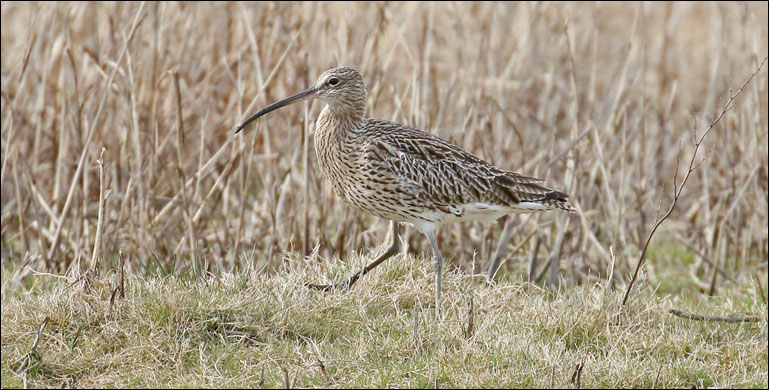There has been a rapid decline of breeding Curlew in the UK in recent years. The UK probably has around 20%-25% of the global population and is therefore internationally important for this species. Various studies have been carried out which highlight the fact that not enough young birds are being raised each year to sustain the population and although predator pressure is quoted as a key factor, there are undoubtedly many other factors such as habitat loss and climate change.
It has been argued that the Curlew is currently the most pressing conservation priority in the UK with half of the breeding population lost over the last 25 years. The Curlew Recovery Partnership (CRP) was launched on 1st March 2021 as a result of two Curlew Recovery Summits hosted by HRH King (then Prince) Charles on Dartmoor in 2018 and 2020.
Curlew were removed from the list of quarry species by MPs in 1981 during the debate for the Wildlife and Countryside Act 1981, but even in the 1994/95 winter edition of Wildfowling Magazine there was an article calling for it to be put back on the shooting list, ridiculing one MP’s justification for his vote stating that “the Curlew has such a lovely call”. I echo that sentiment in that I find the trilling call of displaying Curlew as one of the most evocative bird-sounds of Spring, and sadly one that soon may no longer be heard in Lincolnshire.
Lincolnshire has a very small breeding population but numbers are significantly boosted by birds from Scandinavia, particularly Finland as ringing data suggests. Birds are most likely to be encountered around the Wash and Humber in autumn to spring. A few inland sites host small numbers, such as Marston STW, near Grantham, that regularly holds 30 or so birds in late summer through to April. Many of these birds are wintering Scandinavian birds, and what percentage of locally bred birds occur in these inland groups is not known. Between 1985 and 2009, 77 Curlew were ringed at Marston. We retrapped several ringed birds returning in later winters suggesting that many birds were quite site-faithful. Birds were also subsequently reported from Finland (2), France (2) and one near Arkhangel in Russia (at the time the furthest recovery of a British-ringed Curlew!). An adult Curlew ringed in Shropshire in 1964, was retrapped at Marston in 1984 and again in 1995 (at the time the oldest Curlew from British ringing, retrapped at nearly 30 years after ringing!).

Curlew, Lincolnshire by Steve Nikols April 2018
Unfortunately, very few Curlew chicks have been ringed in Lincolnshire, the first 2 at Nocton Fen in 2004, then a dozen or so at Barkston Airfield between 2005 and 2010. Two chicks ringed at Barkston have been subsequently reported, one dead in France just over a year later, and the other in North Wales just over 9 years later.
Curlew breed on the limestone uplands in the west of the county, and although they also breed in fenland areas of the Ancholme valley, they are completely absent in the fenland areas of south Lincolnshire. One of the strongholds for breeding Curlew in Lincolnshire has been RAF bases, possibly because of reduced predator and disturbance pressures. Breeding records submitted to the Lincolnshire Bird Club have been almost nil in recent years, but that is obviously due to under-reporting – I know for a fact that in recent years, curlew have breed successfully at Barkston and Cranwell airfields and regularly on farmland in the Ancholme valley and near Fillingham north of Lincoln.
In the last two years, Curlew eggs have been taken from RAF airfields in eastern England, and hatched out in captivity and released when fledged under an initiative known as head-starting. It would appear that head-started Curlew from East Anglia have been released on the Sandringham Estate. However Curlew from Lincolnshire airbases have been released on Dartmoor – an area where they have died out naturally, so it would seem almost irresponsible to take Curlew from Lincolnshire where they are still ‘hanging on’ to release them at a site where their future is more than uncertain.
I am told that Curlew eggs are only taken from RAF airfields with a licence granted from Natural England at sites where nests would otherwise be destroyed in the interests of air safety. However, I am not aware that the RAF has deemed Curlew a safety problem in Lincolnshire before this head-starting initiative began, or that nests have been previously destroyed as they have been reasonably successful raising chicks on the airfields in the past. It is difficult to see how much of air safety risk the odd pair of breeding Curlew pose, as during breeding the adults spend most of their time on the ground.
Jim Wright on behalf of the Lincolnshire Bird Club has been given the following figures for eggs taken from Lincolnshire airbases which are as shown below:-
Number of Curlew eggs taken under licence from Natural England 2020 & 2021
| Site | 2020 | 2021 | Total |
| RAF Barkston Heath | 0 | 36 | 36 |
| RAF Scampton | 7 | 44 | 51 |
| RAF Waddington | 4 | 0 | 4 |
| Total | 11 | 80 | 91 |
The figures have surprised many Lincolnshire birdwatchers, who were not aware of the high number of pairs at the first two sites, and makes it all the more depressing as to the loss of breeding Curlew in the county. The recent closure of Scampton as an operational base may be good news in the short term (assuming licences to collect eggs are not issued), but the future development plans for the site may eventually make this site unsuitable for Curlew. I only wish that there was more positive news for this iconic bird.
Report by Alan Ball October 2022









